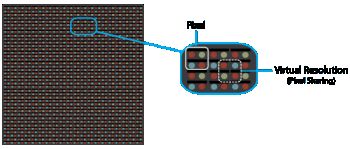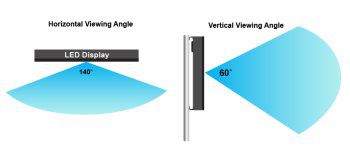Most Common Questions about LED Displays
What Are LED Displays?
LED Displays are called many things: LED Signs, Electronic Display Signs, LED/Electronic Message Centers, Digital Displays/Signs, Reader Boards, and/or Marquees. Essentially, LED Displays are electronic screens composed of many tiny LEDs that work as pixels (much like your computer monitor) to create an image, text, or video.
Terminology:
LED: Light-Emitting Diodes are an energy-efficient, long-lasting, more physically robust alternative to traditional incandescent light bulbs. It is a semiconductor light source that does not contain filaments like light bulbs. So it will not "burn" out. They are often created in small sizes and are capable of fast switching times which make them perfect for use in electronic signage.
RGB: The term for the color composition of displays. Red, Green, and Blue light are used in variation to create the color spectrum.
Pixel: A pixel is a point of light. An LED display is made up of an array of pixels, multiple points of light appearing as dots. A pixel can be as small as one LED or it may contain a cluster of LEDs that act as a unit. Our displays contain pixel clusters of either 3 LEDs (1R 1G B) or 4 LEDs (2R 1G 1B).
Pixel Pitch & Resolution: The pixel pitch measurement is the distance from the center from one pixel (LED cluster) to the next. Pixel pitch can be measured in inches or millimeters. The closer the pixels, the crisper your image will be. For instance, our highest resolution option is 8 mm, which means each pixel is 8 millimeters apart.
Virtual Resolution (VR): Also referred to as EPR (Enhanced Pixel Resolution) or Pixel Sharing. LED pixels are able to share LEDs between them, cutting the distance from one pixel to another in half and doubling the resolution of the display. This results in smoother graphics and video.

Matrix: The matrix of a sign is the number of pixels vertically by the number of pixels horizontally. For example, if a sign has a matrix of 60×140, this means it has 60 pixels from top to bottom and 140 pixels from left to right.
Nit: A nit is a unit of measurement for the brightness over one square meter of a display. One nit is equal in brightness to one candela (approximately the light emitted by one common candle). Nits are used along with contrast ratio and viewing angle to determine the quality of the display image. Nits are often referred to or shown as CDM or Candela per Square Meter (CD/M²). The two are equal measurements.
Viewing Angle: The viewing angle is the maximum angle at which text and images can be seen on a display. A narrow viewing angle causes the text or image to "disappear" from the display as a viewer moves away from a position directly in front of the sign. Viewing Angle is the angle at which the LED's brightness is halved. An LED is at full brightness when you look at it straight on or dead center. If that level of brightness is halved by moving 70° from the dead center, the viewing angle is considered to be double that number, or 140°. The viewing angle of our displays is 140° horizontally and 60° vertically.

Viewing Distance: The viewing distance is the distance from the display in which text and images can be perceived. Maximum viewing distance for LED displays is gauged by the readability of the entire display. For every 1' of display height, there is a viewing distance of 40' (40:1 ratio). For example, an 8' display could reasonably be viewed at a distance of 320'.
Controller: The LED display controller (or computer) sorts out what pixel cluster illuminates when, and at what brightness to create text, reproduce images, and play videos.
Master & Master/Slave Displays: The Master face of a display contains the controller and can operate by itself. In the pairing of two displays, a Slave face lacks a controller and receives a signal from the Master face, displaying the same content.
Temp Probe: A device that measures temperature levels. It can be used to display local outdoor temperatures at the sign location.
What's the difference between the UL and MET Listed Marks?
The UL and MET marks both indicate that the product has met the minimum requirements of the applicable safety standards. Additionally, both marks validate the product's continued compliance with these standards as evidenced by periodic factory follow-up inspections. The main difference between these two marks is the level of involvement and partnership between the manufacturer and the test lab. MET does not believe in putting the manufacturer in a defensive mode. MET's safety engineers are customer-oriented and will keep an open line of communication with their clients to prevent unnecessary and costly delays.
What is an NRTL?
NRTL is a Nationally Recognized Testing Laboratory. In 1970, Congress created OSHA - Occupational Safety and Health Administration - to "assure as far as possible every working man and woman in the nation safe and healthful working conditions." In the same year, OSHA published its regulation 1910.308(d) stating the electrical equipment would be held acceptable "if it is accepted or certified, or listed, or labeled or otherwise determined to be safe, by a Nationally Recognized Testing Laboratory (NRTL), such as, but not limited to Underwriters Laboratories Inc. and Factory Mutual [Research] Corporation." OSHA did not however provide a means of determining how a lab could gain NRTL status.
MET sued OSHA three times. This eventually resulted in the creation of a set of criteria to which a lab could prove itself to be worthy of NRTL status. In June 1988, MET became the nation's first NRTL, making good OSHA's pledge to undo the "anti-competitive effects" created by its regulations. Thanks to MET Laboratories, manufacturers were freed from the stranglehold of an implied federal monopoly.
Since UL writes the safety standards, don't manufacturers need to display the UL mark?
The legal requirement is that the laboratory that performs the testing is a Nationally Recognized Testing Laboratory (NRTL) recognized by OSHA. While UL does coordinate standards writing, they are only one of several NRTLs for testing and certification.
Do retail stores sell products with the MET Listed Mark?
MET-listed products have been sold in more than 7,000 retail stores throughout the United States and Canada. The MET Mark indicates that the product has been evaluated for safety by an approved independent lab following the national standard. MET is available to provide the necessary information if any retail store requests clarification of the national requirements. Retailers accepting products that bear the MET NRTL Mark include Walmart, Best Buy, Lowe's, Home Depot, Sears, Staples, Target, Radio Shack, and HSN.
How does the MET label prove that a product meets the national requirements?
The MET Mark indicates national compliance under MET's equivalent accreditations to UL and CSA. The MET mark indicates compliance with US and Canadian requirements. At the client's option, the MET mark can specify the applicable UL and/or CSA standard to which the product complies.
The MET Sign Shop Program is for Sign Shops seeking a listing of their electrical/electronic signs to:
- UL48 and NEC (National Electrical Code) For U.S.
- CSA 22.2 No. 207 and CEC (Canadian Electrical Code) for Canada
What is covered by the MET Sign Shop Program?
- All signs regardless of voltage are electrically operated and/or electrically illuminated.
- Illumination: incandescent, fluorescent, high-intensity discharge (HID), electric discharge tubing including neon tubing, light-emitting diode (LED), skeleton neon tubing, cold-cathode lamps, and electroluminescence.
- The term "sign" includes signs, outline lighting, art forms, and skeleton neon tubing.
- Specifically, these types of signs are included:
- Awning signs
- Trailer-mounted signs
- Electrically or mechanically animated signs
- Signs supplied by photovoltaic systems and other independent power sources
- Changing message signs
- Scrolling
- Flipper
- Tri-view
- Liquid Crystal Display (LCD)
- Light-emitting diode (LED) type and
- Other electrically operated signs that are not, necessarily, illuminated
34